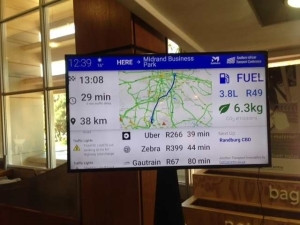
To encourage a culture of using public transport, the creators of the social transit app and Web site GoMetro have introduced a traffic streaming service.
The GoMetro TV service is intended to show users in buildings how bad traffic is in the immediate vicinity so they can either reconsider undertaking their journey right away, or use a different mode of transport.
According to GoMetro CEO Justin Coetzee, the GoMetro TV device streams traffic and transport information for users by being connected to TVs in public spaces like office lobbies, airports, convention centres, hotels, hospitals, universities and schools.
Coetzee says: "GoMetro TV will hopefully show them just how bad the traffic conditions are, and make people think about the Gautrain, Metrorail or the MyCiti and Rea Vaya buses as an option to get around.
"Very often, public transport using a separate way (like Metrorail from Century City to Brackenfell) is as fast as a private car in traffic conditions, but users have not considered that as a viable option. Certainly, the Gautrain will almost always beat a car travelling from Pretoria to Johannesburg in the morning."
Step backwards?
The GoMetro app and Web site was developed by the start-up also called GoMetro. The app was launched to provide Metrorail commuters with information on real-time train schedules, train fares, timetable deviations and platform changes.
Users in Gauteng, the Eastern Cape, Western Cape and KwaZulu-Natal can access information to plan their trips and get notified of any delays.
Having started with Metrorail train times, GoMetro expanded its services to provide commuters with information about both train and bus services. Gautrain, MyCiti and Rea Vaya commuters can now also access their required travel information.
The company then decided to further diversify its services to include the GoMetro TV offering.
Coetzee explains: "GoMetro TV will help us reach users who we haven't reached yet. We have apps and a Web site used on a daily basis by thousands of South Africans ? but we have to think outside the box when it comes to reaching people who are in love with their cars.
"GoMetro TV can help reduce greenhouse gas emissions. The TV shows you exactly how much CO2 a particular trip will consume. So it will make a driver think twice about using their own cars when they realise they produce up to two tonnes of CO2 a year. GoMetro TV promotes ride-sharing by co-workers, which reduces traffic on the road and saves people money."
How to guide
While the GoMetro app and Web site provide transport information to commuters who have downloaded the app, GoMetro TV intends to make traffic information available on a more public scale.
Coetzee says the perfect and ideal places for the GoMetro TV device are airports, convention centres and hotels.
By plugging the GoMetro TV device into the high-definition multimedia interface port of the TV and connecting to WiFi, GoMetro TV streams traffic and transport data to the TV's location.
GoMetro TV provides all transport options such as private cars, public transport and metered services. It offers options to choose from such as Metrorail, MyCiti, Golden Arrow, minibus-taxis, metered services, and motorbike and walking routes.
"The content will include road speed, incidents in the area, queue-lengths and other traffic data we collect around the building. The screen also shows the nearest Uber locations and compares the private use with a ride-sharing option. It cycles through various major destinations in the area and shows viewers how long it will take to get to each destination by car, cab and public transport."
Share